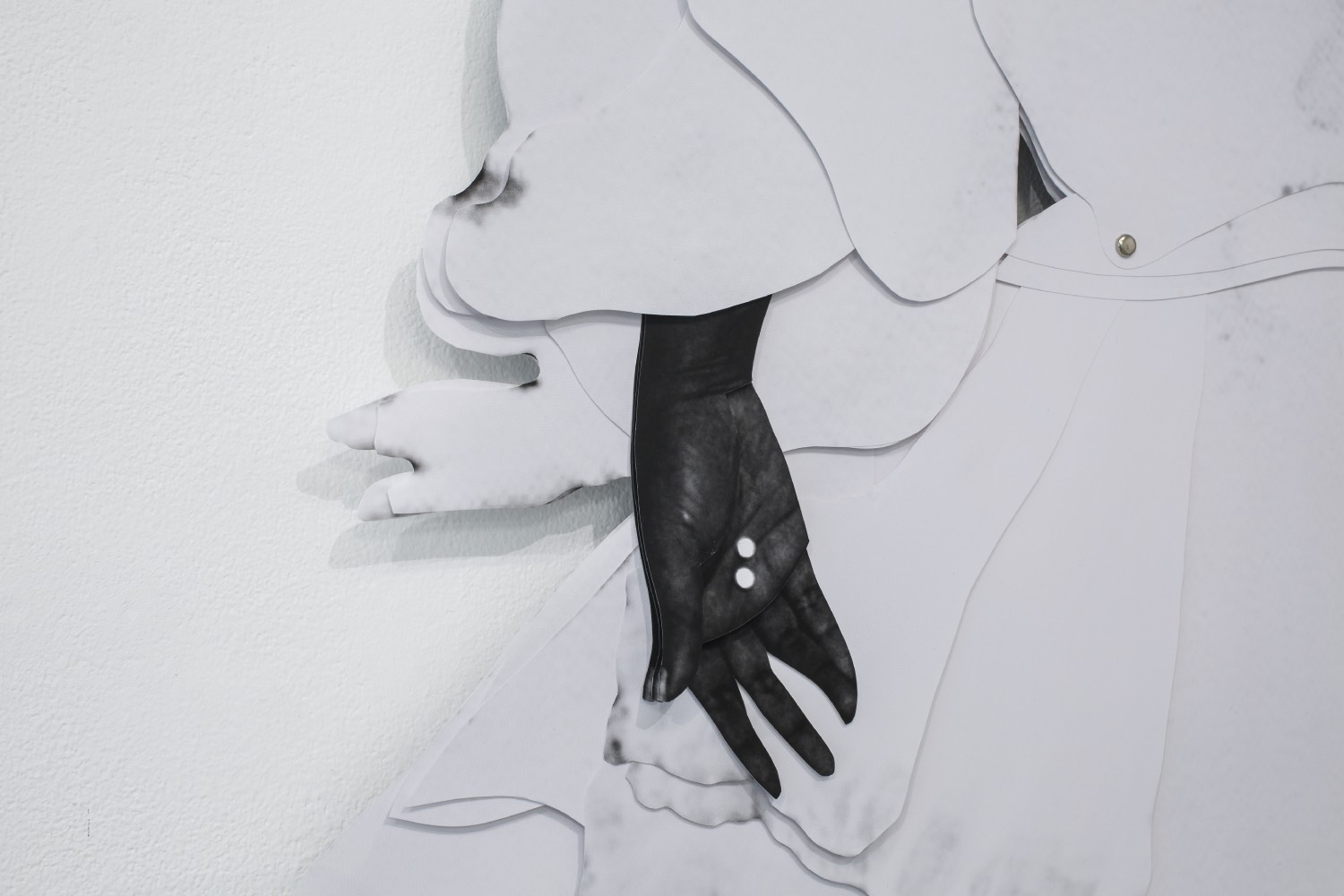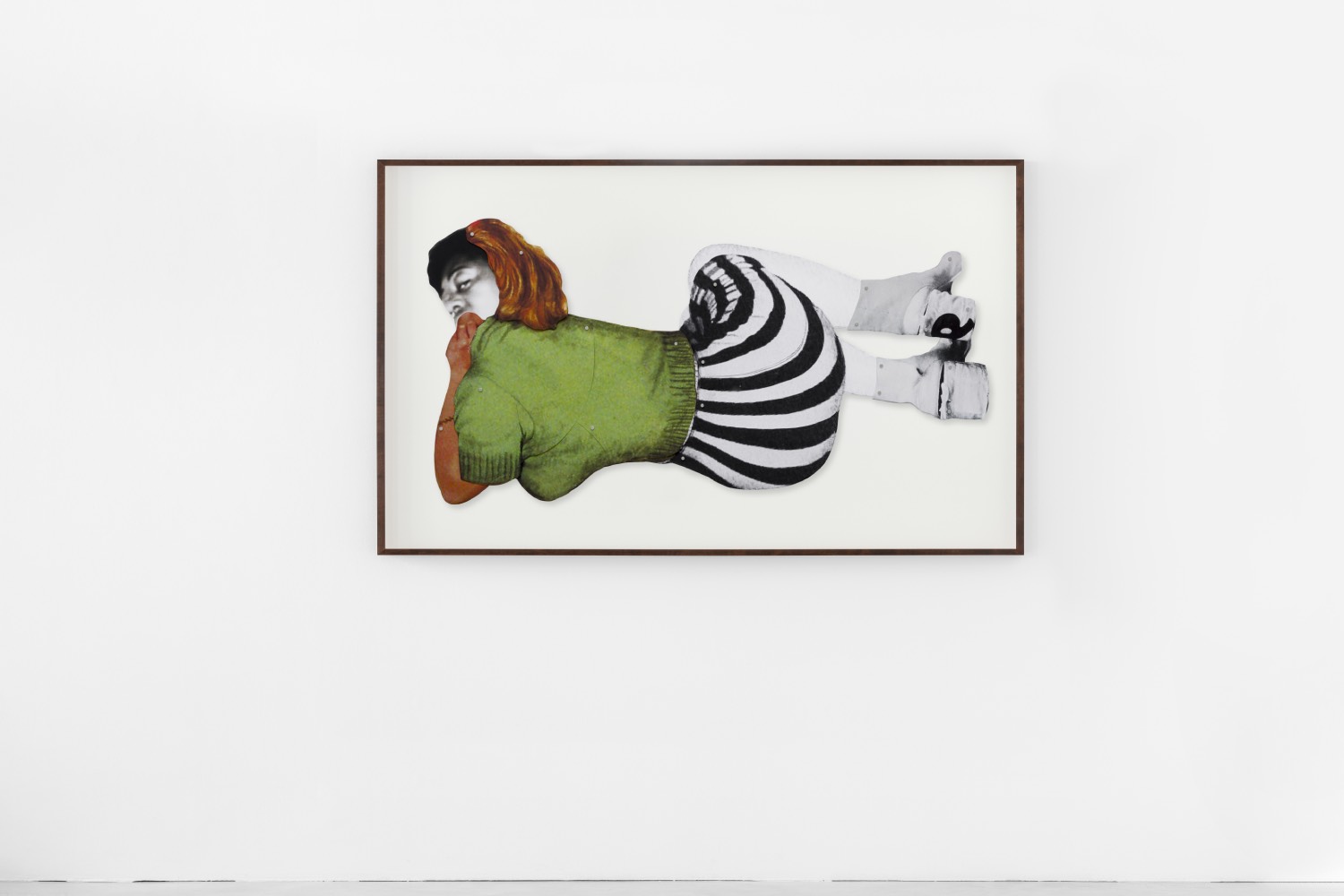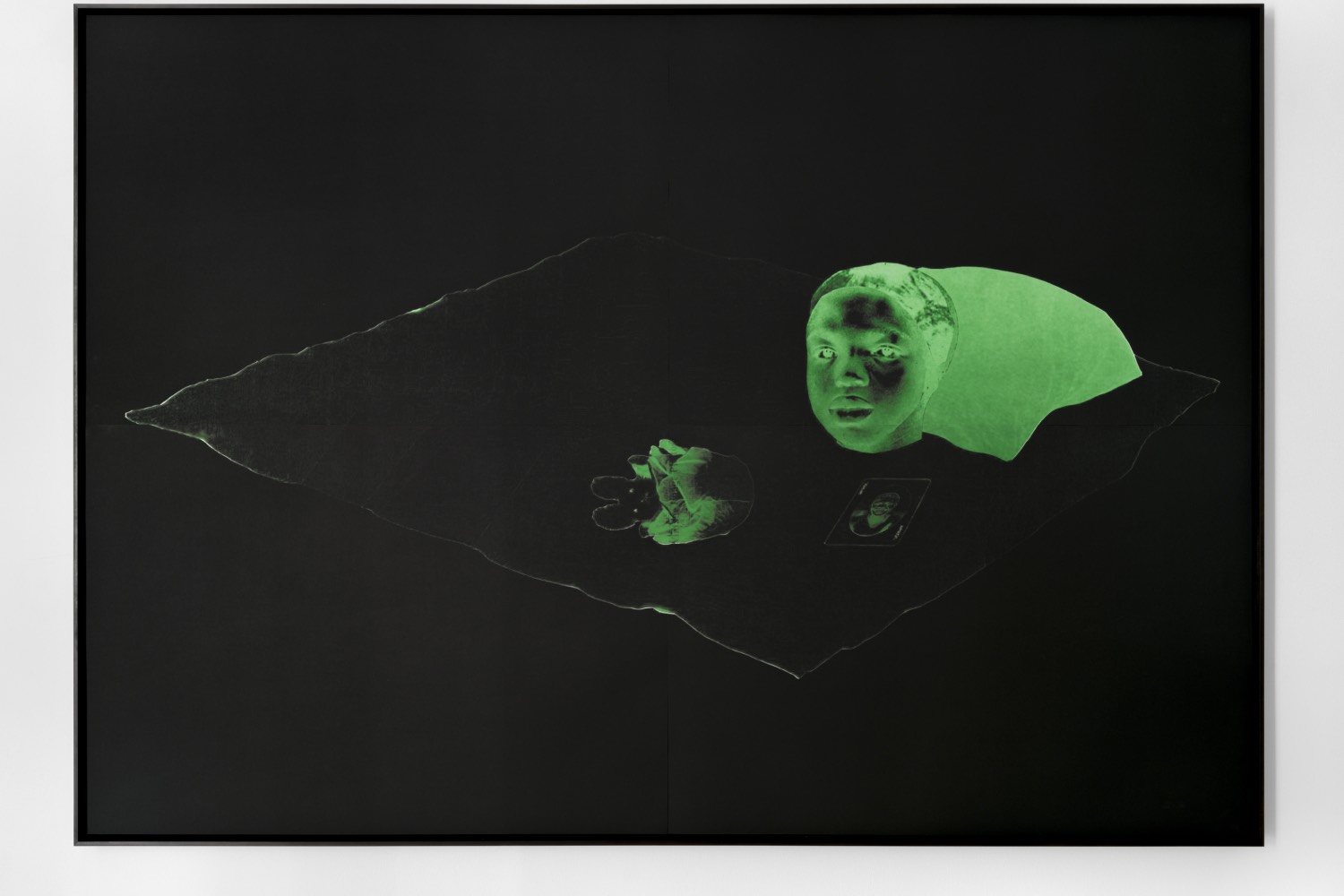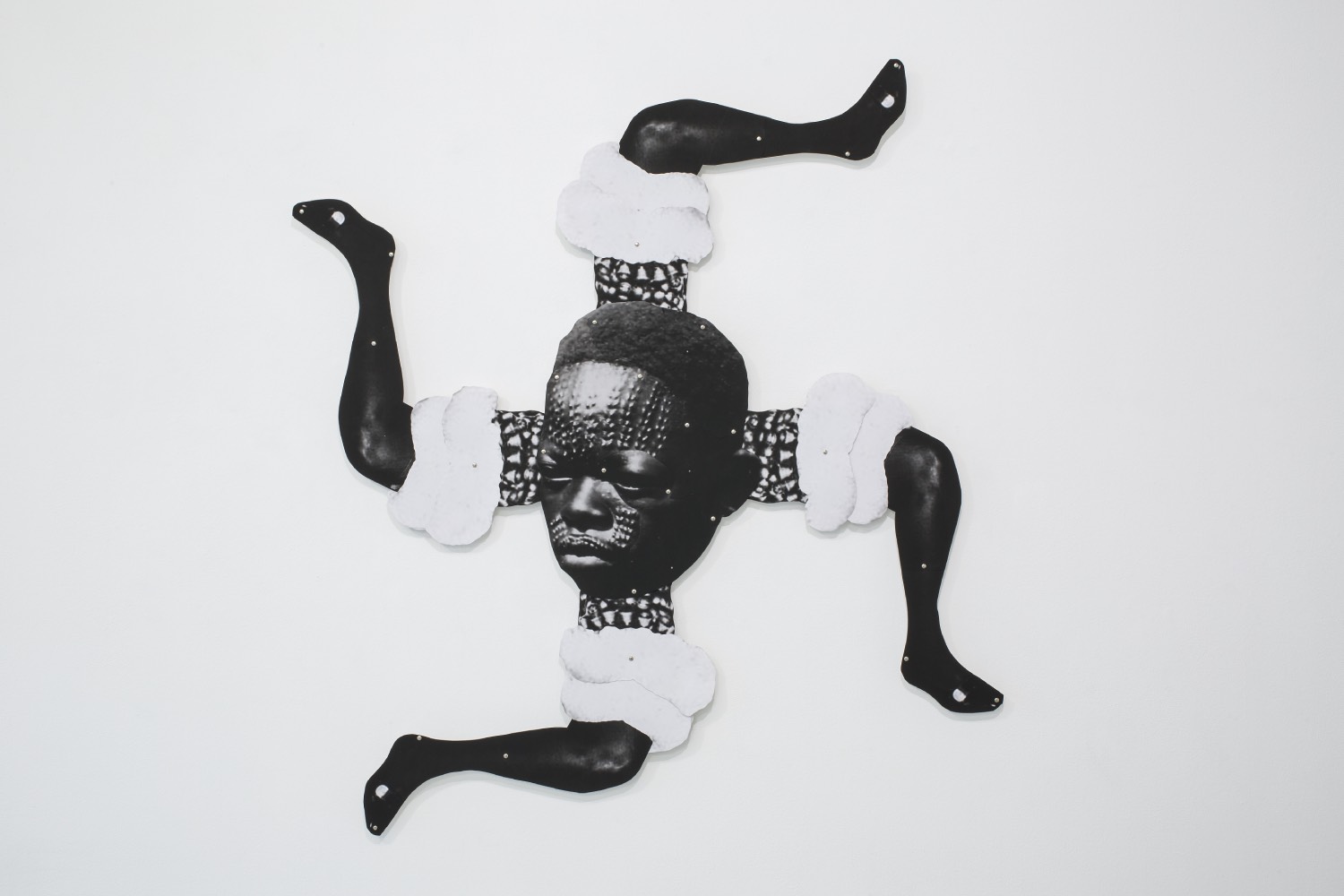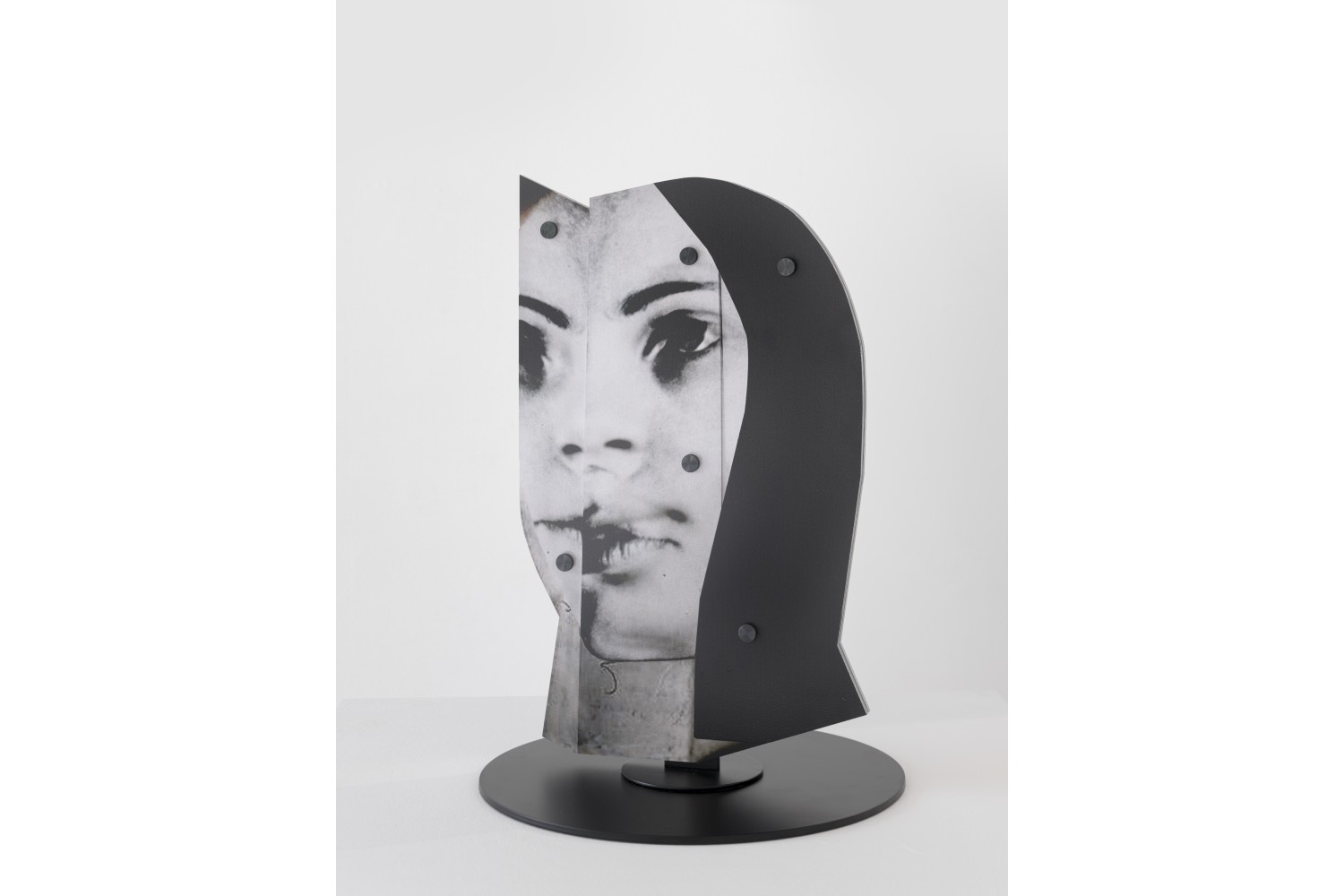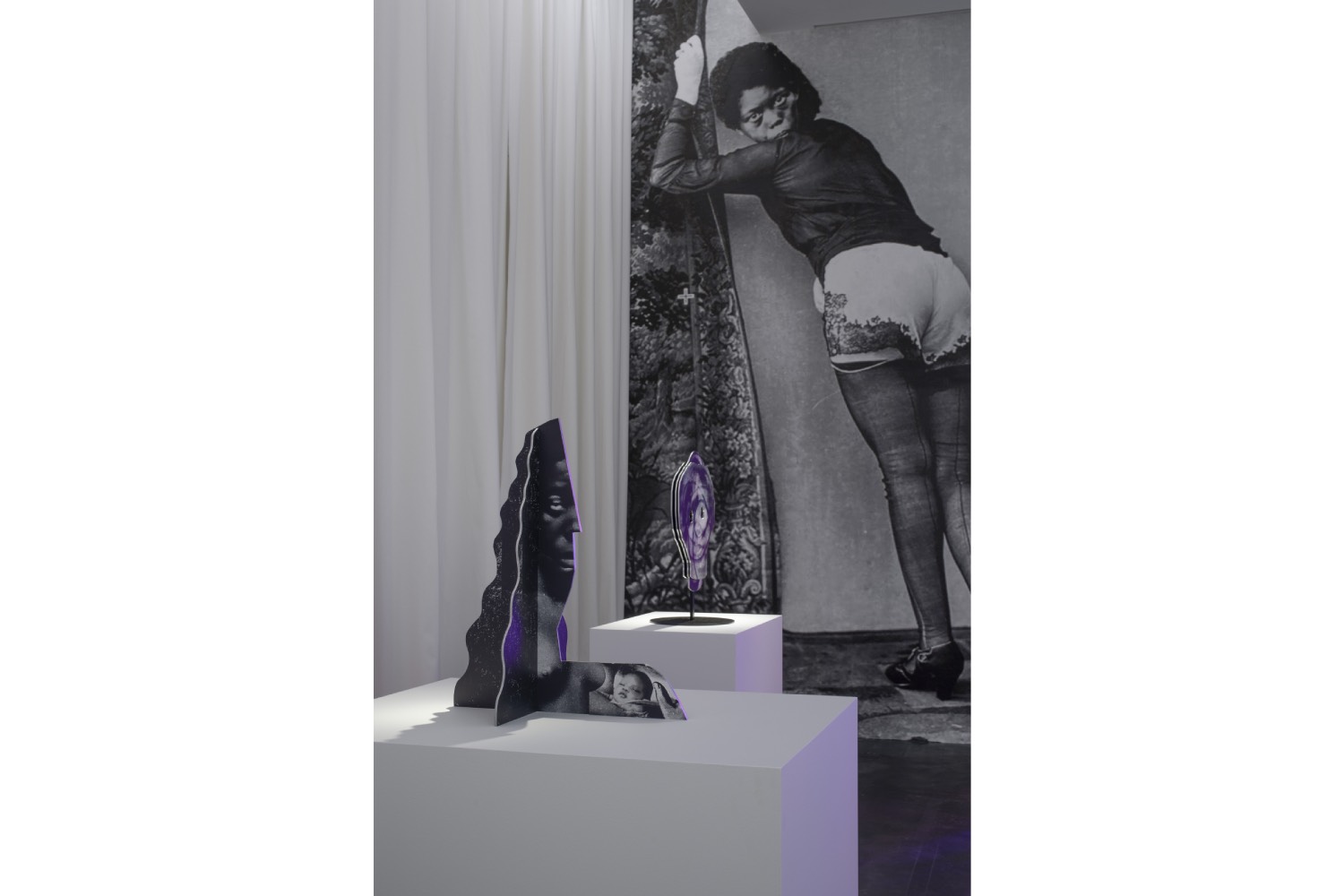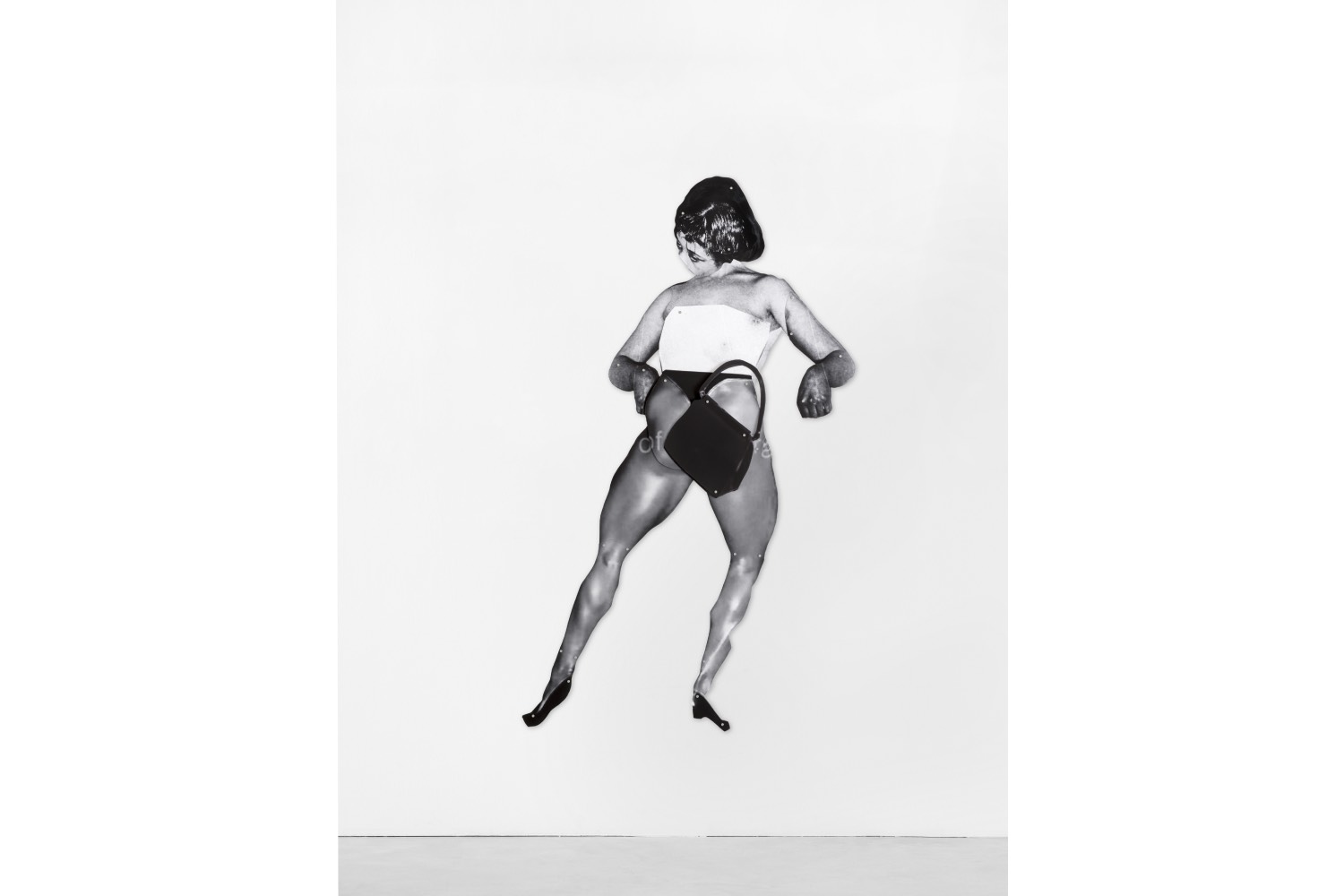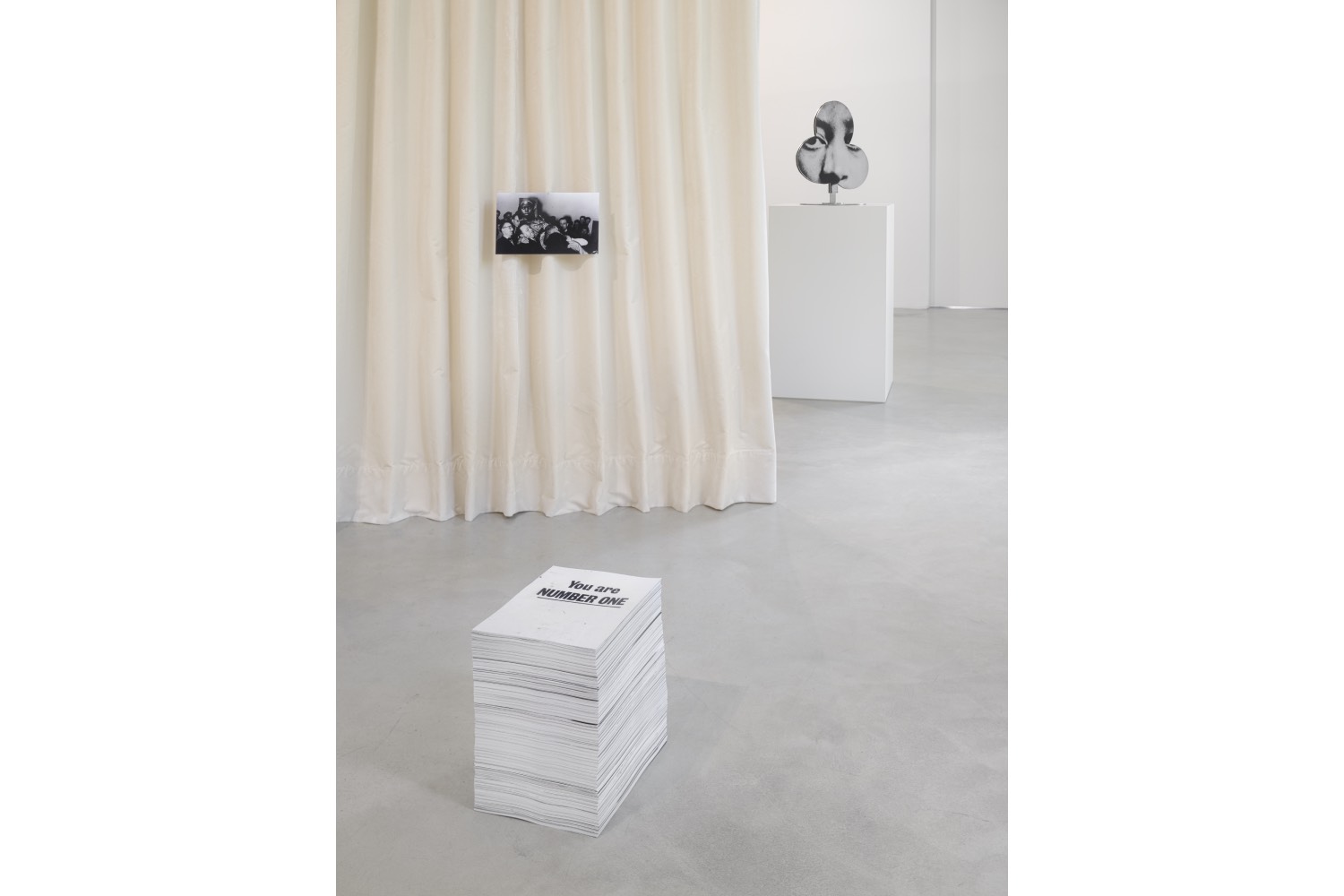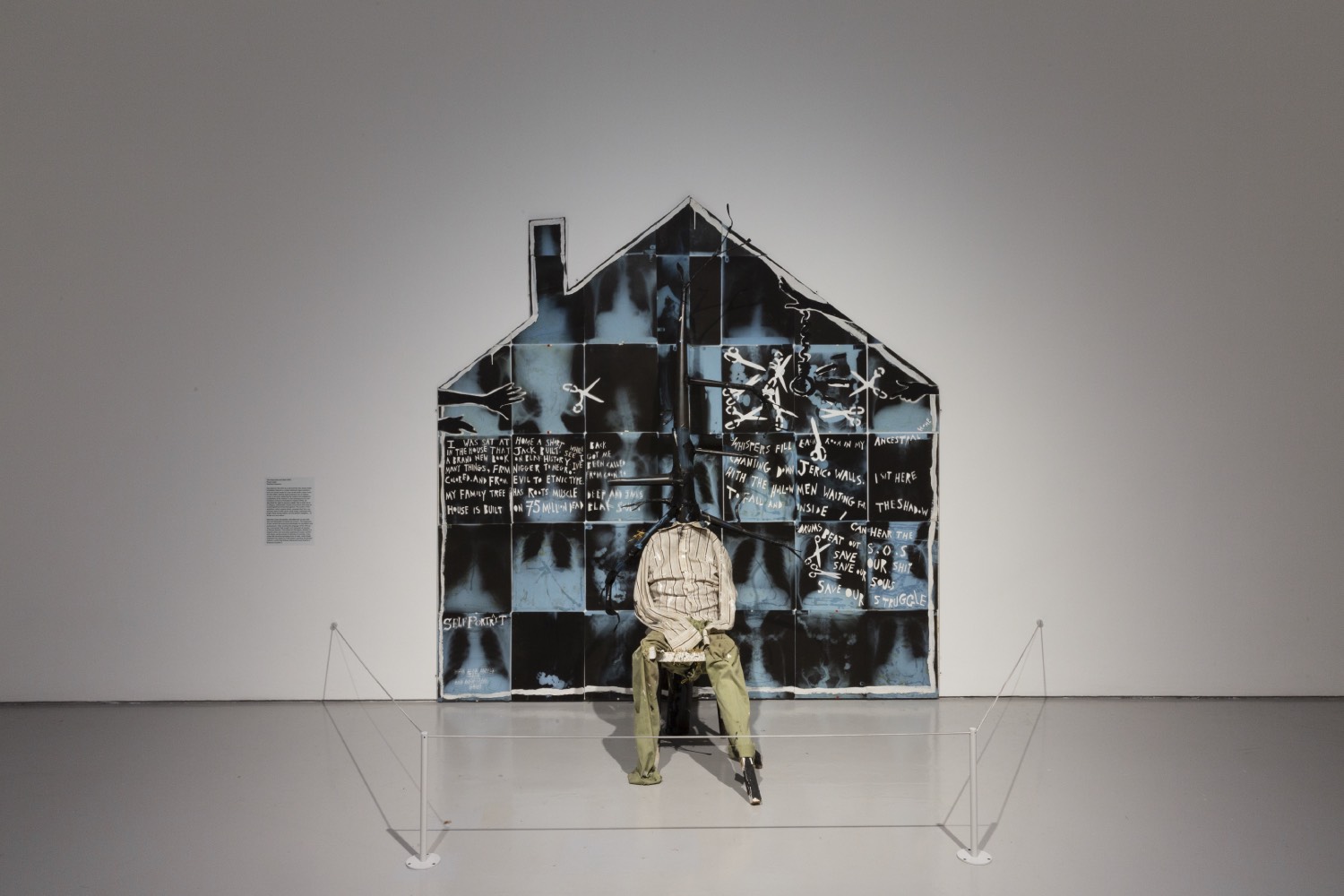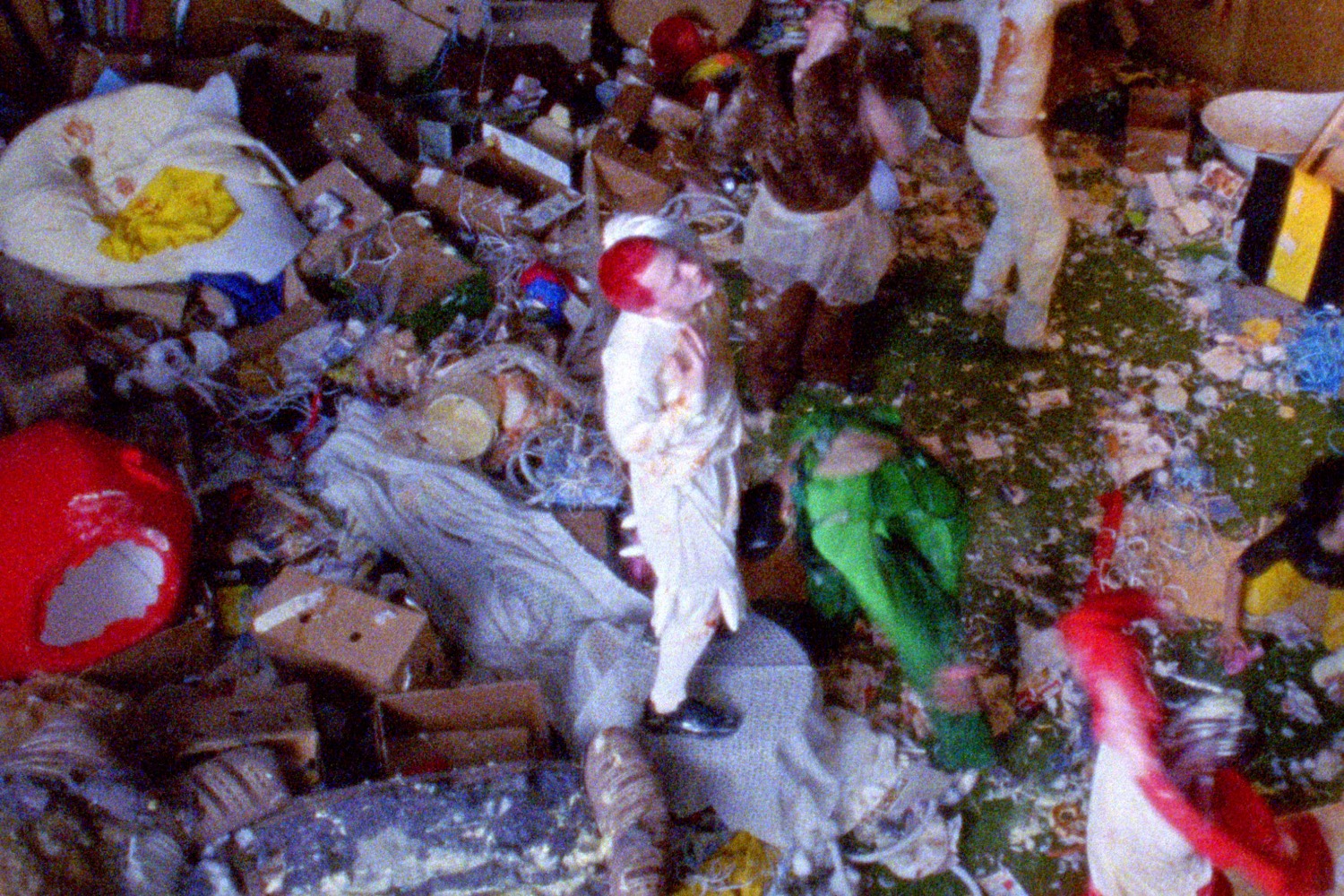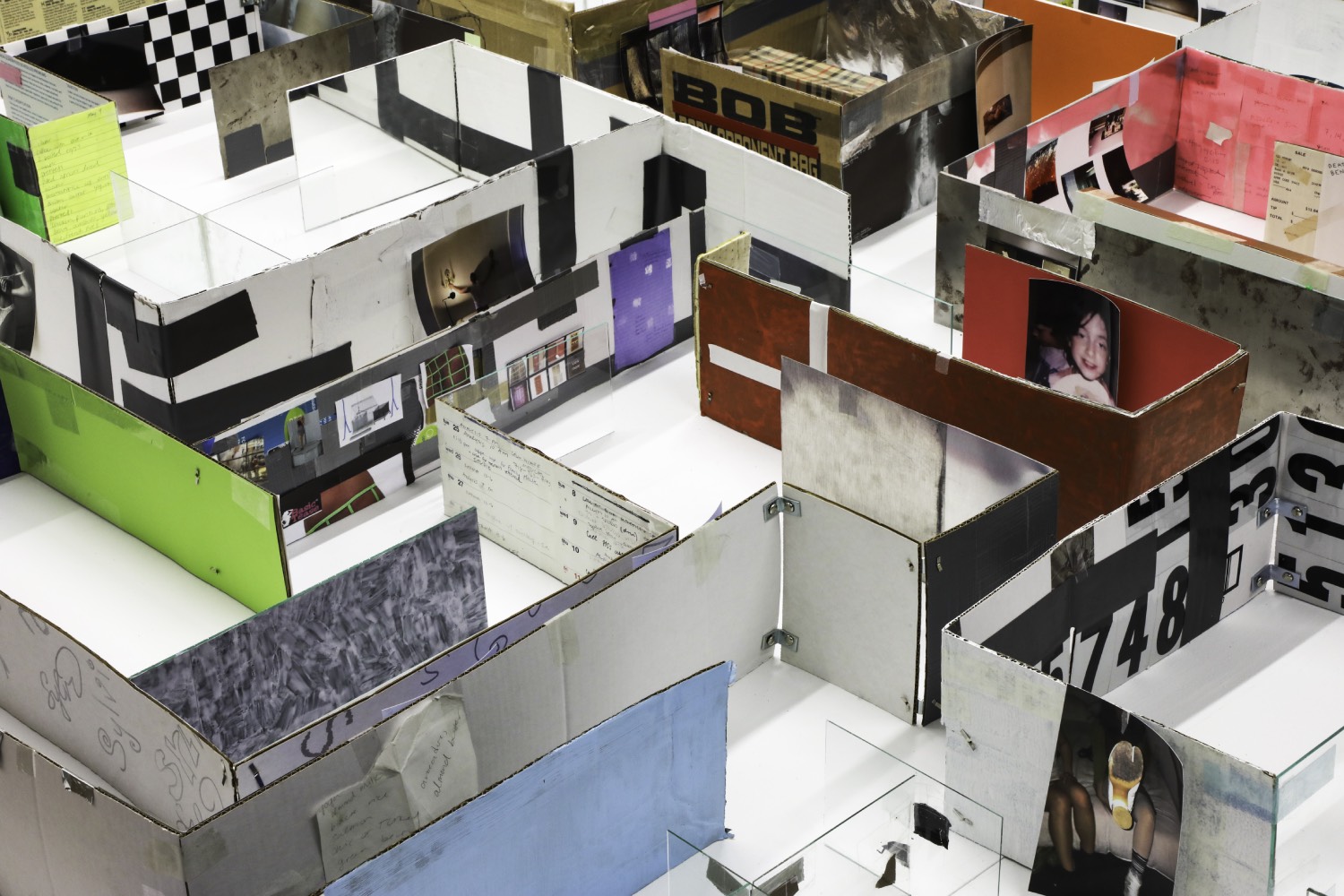Frida Orupabo’s work is uncompromisingly and unapologetically confrontational. Sifting through images in colonial archives, magazines, Tumblr, eBay, Renaissance paintings, B movies, and pornography, she lifts limbs, heads, weapons, clothing, domestic objects, and animal parts and reconstitutes these into new bodies. Originally, her creations were digital, shared via her Instagram handle, but her collages later became large-scale works on paper, fixed with pins and distributed in disturbing mise-en-scènes across gallery walls and plinths. In her recent exhibitions, figures have migrated to aluminum, to stand as sculptures in the space, and as overlaid film stills displayed on flickering cube monitors. The viewer is surrounded, under the stare of multiple eyes, unsure of having permission to look. Each composition is the result of an instinctive choice, a moment in which Orupabo’s gaze was arrested while navigating streams of images. These moments are assembled into new beings, their Frankenstein composition augmenting an original friction, melancholy, and violence, but also staging a new viability and visibility on their own terms. Orupabo is an astute register of affect, or, as Black feminist scholar Tina Campt has described, “visual frequency”1 — a resonance in Black visuality that registers beyond content. Campt positions this as a form of attentiveness and knowledge production that operates beyond language and “gives us profound insights into the everyday experiences of black folks as racialized subjects.”
Orupabo describes these newly constituted beings as “subjects” that forcefully reject the objecthood of white culture and the racial logic forced on Black people for centuries. As Fred Moten opens in his exploration of Black subjectivity and performance titled In the Break (2003), “The history of blackness is testament to the fact that objects can and do resist.”2 The movement from object to resistant subject works in numerous ways in Orupabo’s art. Firstly, it is in her choice, her cut, and the rearrangement of fragments into new images that weren’t available to her growing up outside Oslo as a Black Norwegian woman with Nigerian heritage. These range from those that are shocking in their absence — a simple image of a Black woman seated on a horse — to complex representations of Black women owning the ambivalence of childbirth or the erotic charge of their bodies.
Most directly, watermarks float spectrally over some images, visually presenting an ongoing ownership and objectification of Black life. Online images of unknown Black figures are owned by image licensing companies, from which they benefit fiscally in perpetuity. Questions also arise around the use of pictures held in archives, as articulated in recent cases of relatives claiming images as depicting their own family members. In 2019, a descendant of two enslaved people who feature in daguerreotypes held by the University of Harvard asserted that the university was profiteering from the photographs and perpetuating a state of slavery. The affront was deepened in that the images were made by Louis Agassiz in South Carolina in 1850, a biologist whose purpose was to prove the inferiority of people of African descent. Orupabo riffs within these margins, making newly evident the terrible role that the medium of photography played in promulgating racism as a science and which is now deployed as a tool of surveillance and control. However, this critique is moved past and through to signal the formidable power of deploying the photograph as an exalting mode of reclamation.
Orupabo’s use of found or recovered photographs forces open the gaps and silences in contemporary image culture and the official archive, summoning scholar Saidiya Hartman’s radical archival practice of “critical fabulation” in which one listens for “the unsaid, translating misconstrued words, and refashioning disfigured lives.”3 This disfigurement is both physical and psychological, a rupture that Orupabo’s cut points to but that her reassembling addresses. The cut between collaged elements is palpable, made more abrupt in later works so as not to smooth over or repress the original violence but to point toward a powerful reformulation and self-authorship.
The gaze is the operative force in Orupabo’s collages, sculptures, and films. She often selects faces for her works based on the quality of their gaze, seeking ambiguity and confrontation. To view the works, we must meet these looks. Campt’s work on this is incisive in describing the Black gaze as a practice of looking that positions the viewer in a relationship to Blackness. She asks what it might mean to take up this practice at a time of precarity for Black subjects and the questions it raises as to how you deal with your implication in that precarity.4Orupabo’s works foreground the act of looking, demanding that we “actively inhabit a state ranging from disorientation and unease to […] vulnerability and that we work through these responses to come out somewhere new.” 5 In the work Untitled (2019), a woman lies on her back, arms cradling her head in a position of display common in art-historical nudes, but also redolent of the slave market demands on the female body as an object for mercantile assessment and unfettered access. A blackbird’s head protrudes disturbingly from her vulva. We meet her stare, which makes uncomfortably resonant that the climate for Black women remains one of sexualized hypervisibility and enforced objecthood; a context Orupabo became intimately aware of during her time providing social services for sex workers in Oslo. How do we attune to the visual frequency of this work? It holds an intentional opacity that works against the hypervisibility demanded of Black bodies and activates an awareness of the differing reception for a Black or white audience. Her stare triggers an intentional friction and discomfort, dependent on the viewer, reflecting whiteness back at itself. Following Moten again, “Blackness, in its irreducible relation to the structuring force of radicalism and the graphic, montage configuring of tradition, and perhaps most importantly, in its very manifestation as the inscriptional events of a set of performances, requires another thinking of identity and essence.” Orupabo’s work demands we rethink identity, essentialism, and assumption to open up new spaces of possibility.
A powerful series in her work focuses on childbirth, drawing on the artist’s difficult experiences of labor and postpartum realities. Untitled (2019) announces a Black woman contorting her body as a baby’s head forces its way from her vulva. Her gaze is averted down to the ground. Is she ashamed? Accepting? In a trance? A further examination reveals she has no breasts. Can she nurture the child post-birth? In another, Love At First Sight (2021), a woman in the pose of an odalisque looks at us empty-eyed; her head seems to be affixed to a white female body, and her child’s head is twisted unnaturally back on itself. Orupabo thought deeply about Black maternal mortality during the making of these works; it’s a contemporary reality that health outcomes during labor for Black women are statistically more likely to be poor. Historically, in the lives of Black enslaved women, childbirth was a devastating time in which the mother was cruelly separated from her child and perhaps forced to play nurse to another’s children. The ghost of Toni Morrison’s Beloved (1987) looms large.
The gesture of the cut, both in the digital splicing of her images and in the reoccurrence of injuries and fleshy incisions in various images that she presents, is a vivid and resonant presence in the work. Knives are brandished or appear on their own. Paper, like skin, is only so deep, but skin and its pigmentation have defined the horrific destiny of enslaved Africans and the ongoing racial discrimination and violence faced by Black subjects today. The cut also points to the abjection described by Julia Kristeva and the operative mode of the horror genre, with which Orupabo is increasingly engaged for its vivid imaginary but also its proximity to the trauma and violence of the Black experience. Grainy frames from 1970s horror movies pepper her Instagram feed; a knife plunges into skin, drawing blood in The Cremator (1969) alongside segments from Night of the Cobra Woman (1972), Zuma (1985), and La Vampire Nue (1970). This channel pragmatically operates as her ongoing archive and as an open-resource exhibition space. It was the original site for the distribution of her work and garnered the attention of Arthur Jafa, who invited her to exhibit as part of his show “A Series of Utterly Improbable, Yet Extraordinary Renditions” (2018) at Serpentine in London, which precipitated her move to physical collage and her propulsion into the art world. Monsters stalk her exhibitions and online feed — masked, predatory, and violent. Orupabo seems drawn to the monster, whose cultural formulation has long been associated with a threatening non-normativity and excessiveness of women, queer, disabled, and Black subjects. Here, she also riffs on the positioning of the Black male in the historic white imaginary as a nightmarish “other,” threatening sexual and physical violence.
Scouting the internet for interviews with Orupabo, I was struck by footage of her working in her apartment, swapping in printed sheets of paper with each other to create new figures, fixing them together with tape before perforating them with the pin into a new configuration. This movement is the shadow performance of their final presentation in the exhibition format, one of defiance, resistance, and hope.

